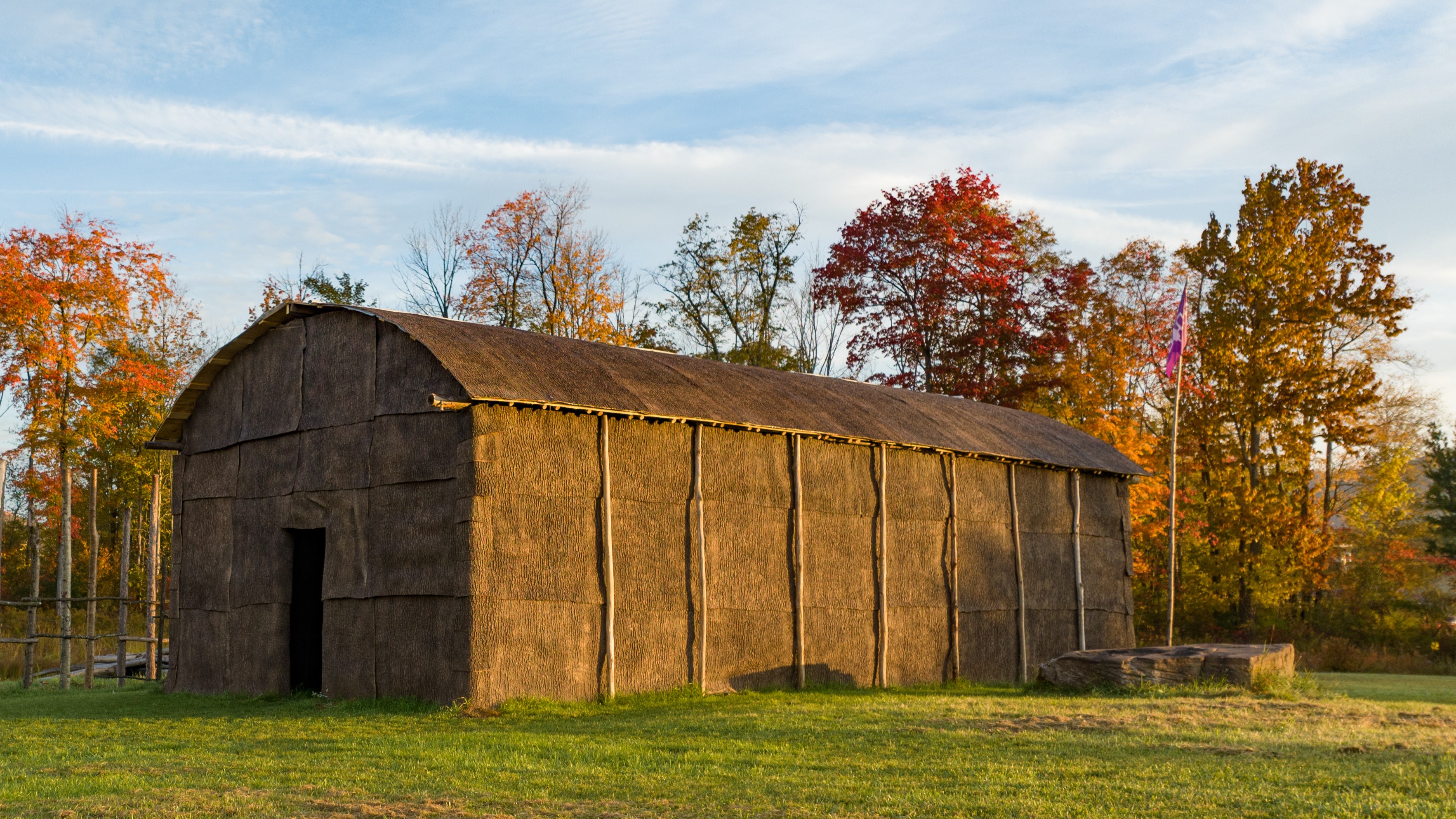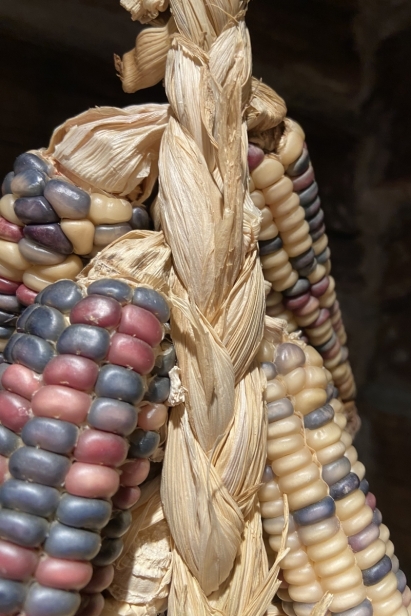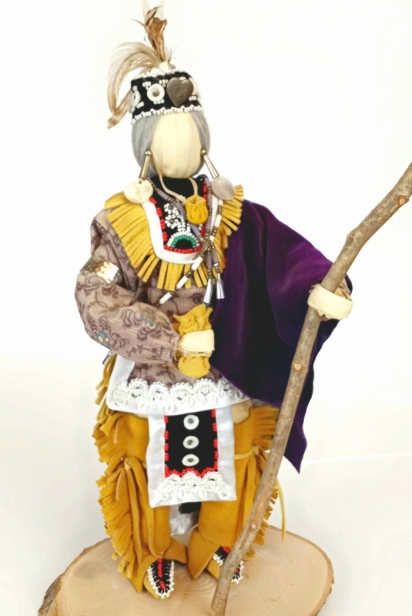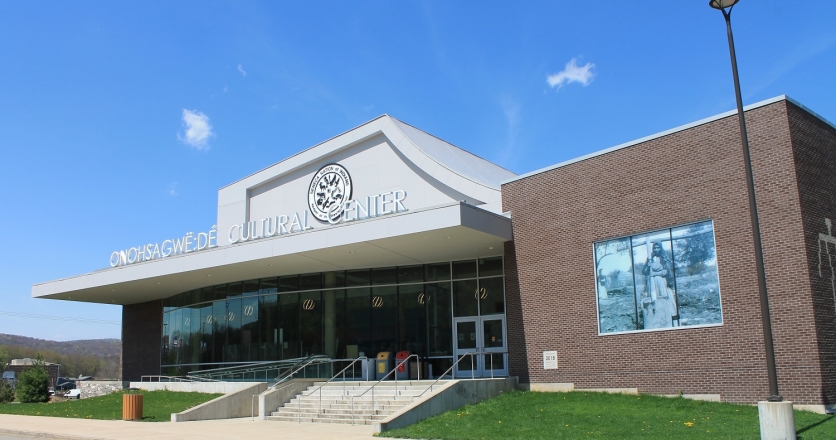Corn, Art and the Seneca Nation
Among the Seneca, a nation of indigenous people who originate from the Rochester, NY, area and west to Lake Erie, corn has always been known as one of three life sustainers that they refer to as the “Three Sisters.” The other two are beans and squash.
According to Gerry Fisher, a Seneca woman who is the acting director of Gakwi:yo:h Farms, a Seneca agricultural site, the significance of corn is a large part of Seneca identity. “It is who we are as native (ögwe’ö:weh) people,” she says. “Our corn has sustained our ancestors for generations.”
HISTORY
Corn has always been an important crop to the Seneca because of its ability to grow abundantly in its environment and for its versatility. In the spring, it’s planted. In the summer, it grows. In the fall, it’s harvested. In the winter, it’s preserved, and the cycle repeats to ensure corn is eaten all year round.
According to historians at the Ganondagan museum in Victor, NY, which is southeast of Rochester and an original site of a Seneca village pre-1700s, it’s specifically white corn that was eaten.
White corn today is “traditionally managed and protected to create nutritious corn products from heirloom seeds dating back at least 1,400 years in (Seneca) communities,” cultural experts from Ganondagan write on their website. “Handgrown, hand-picked, and hand-processed, White Corn products are non-GMO, gluten-free, and have a low glycemic index.”
For Seneca people, corn is cooked and prepared to be eaten in several ways. It’s made as a traditional bread that’s shaped into a wheel and boiled in water; as a mush, served during winter ceremonies; and, most popularly, as a soup.
When the soup is made following proper tradition, the process is lengthy, taking more than a day to cook thoroughly and requiring attention to detail.
First, the corn is washed and cooked over a fire in water with ashes from wood chips, usually hickory. Lye from the ashes causes nixtamalization, a process that results in the kernels bursting open and yielding soft, white, fleshy niblets called hominy. Then the hominy is rinsed several times to remove the lye.
Once the corn is fully rinsed, it’s cooked for several hours in a fresh pot of water with ham hocks, salt pork and kidney beans.
Everything cooks together for a harmonious pot of soup.
Advancements such as canned hominy and kidney beans and vegetable stock can all be purchased from supermarket shelves for quick convenience, but people prefer to make it—and eat it—the traditional way, especially for special occasions and large gatherings.
At Gakwi:yo:h Farms, Fisher says that their goal is in reducing, reusing and recycling everything they use.
“Not being wasteful is the goal of the farm,” she says. “We are composting and once our processing kitchen is finished, we will be preserving excess food from our garden.”
Corn braiding, Fisher adds, was how corn became more than sustenance and how it also became art.
“It was the way we dried our corn, which was primarily done by the men,” she says. “The women used the husks to make dolls for the children, masks, mats and moccasins. The cobs were used to make pipes and used as fire starters (kindling) and the corn silk was used for medicine.”
“Nothing was wasted,” Fisher says. “Corn had a use in everyday life for our ancestors.”
CORN AS ART
Bernadette Scott, from the Cattaraugus Territory near Gowanda, is one of three sisters who has created corn husk dolls for almost 30 years. She picked up the skill from her mother and grandmother. Through the years, Scott has both created the dolls for show and taught children and adults all across New York State how to make them.
Scott’s dolls are made without faces because corn husk dolls are based on a legend. In the story, a corn spirit doll becomes vain and admires her own face so much that the Creator takes it away, as a reminder to people to be humble and not conceited.
To make the dolls, the husks are soaked in water to make them pliable. Then, Scott takes one husk and rolls it into a ball to form the head. Over that, she places another husk to create the torso, and ties it with sinew at the edge of the ball to make a neck. More husks are braided, then added to the torso for arms and legs. The dolls are left to dry and then clothing is added.
“At first, it was a challenge to make the tiny clothes for them,” Scott says. “Once I made a few items, it became a lot of fun. I love getting creative with it.”
The best part about making the dolls is the connections she makes. “I’ve enjoyed traveling and teaching new people,” she says. The dolls are also a way to use every part of the plant and give thanks for corn’s several uses and sustainability.
Sierra Parker, a Seneca woman from the Allegany Territory at Salamanca and niece to contributor Vanessa Parker, owns and operates Bittersweet Florals. Parker creates flowers from corn husks in her shop, which she blends with real and artificial flowers, then arranges them artfully in contemporary and traditional pottery. She created the shop with inspiration from her grandmother, Kathy Pierce Mitchell, who died in 2010. Parker hopes to carry on the craft in her honor.
“Knowing that I carry on one of my grandmother’s traits of traditional Iroquois art brings back so many good memories,” she says. “Not a lot of artists focus on floral with corn husk, so I am very happy I grew up knowing what I know.”
Bouquets, wreaths, boutonnieres, corsages and tabletop arrangements are what she creates the most. She uses the corn husks both natural and treated with colorful dyes, sets them aside to dry overnight, then forms each husk into petals by hand, gathering them into floral patterns and shapes.
She says that making flowers as gifts, teaching others in both Cattaraugus and Allegany Seneca territories how to create their own flower arrangements, and learning the patience and hard work necessary to create these baskets, has been such an honor.
“I am so happy to provide a unique, cultural art for everyone to experience,” Parker says. “This art has changed my life for the better.”
WORTH A VISIT
The Onöhsagwë:de’ Cultural Center in Salamanca, NY, features a variety of artwork and exhibits that tell the history and stories of the Haudenosaunee. There are a number of new exhibits on display, one of which is centered around renowned Seneca artist Carson Waterman and his life works. Another is the Living Longhouse, a historically accurate replica, complete with benches, firepits, functioning smoke holes and a variety of artifacts significant to everyday life in a longhouse. Adjacent to the Living Longhouse, the Jöhehgöh (life sustainers)—corn, beans and squash—grow in the community garden. Work by Seneca artists, including corn husk dolls, and white corn products grown and produced at Gakwi:yo:h Farms are available in the gift shop.









